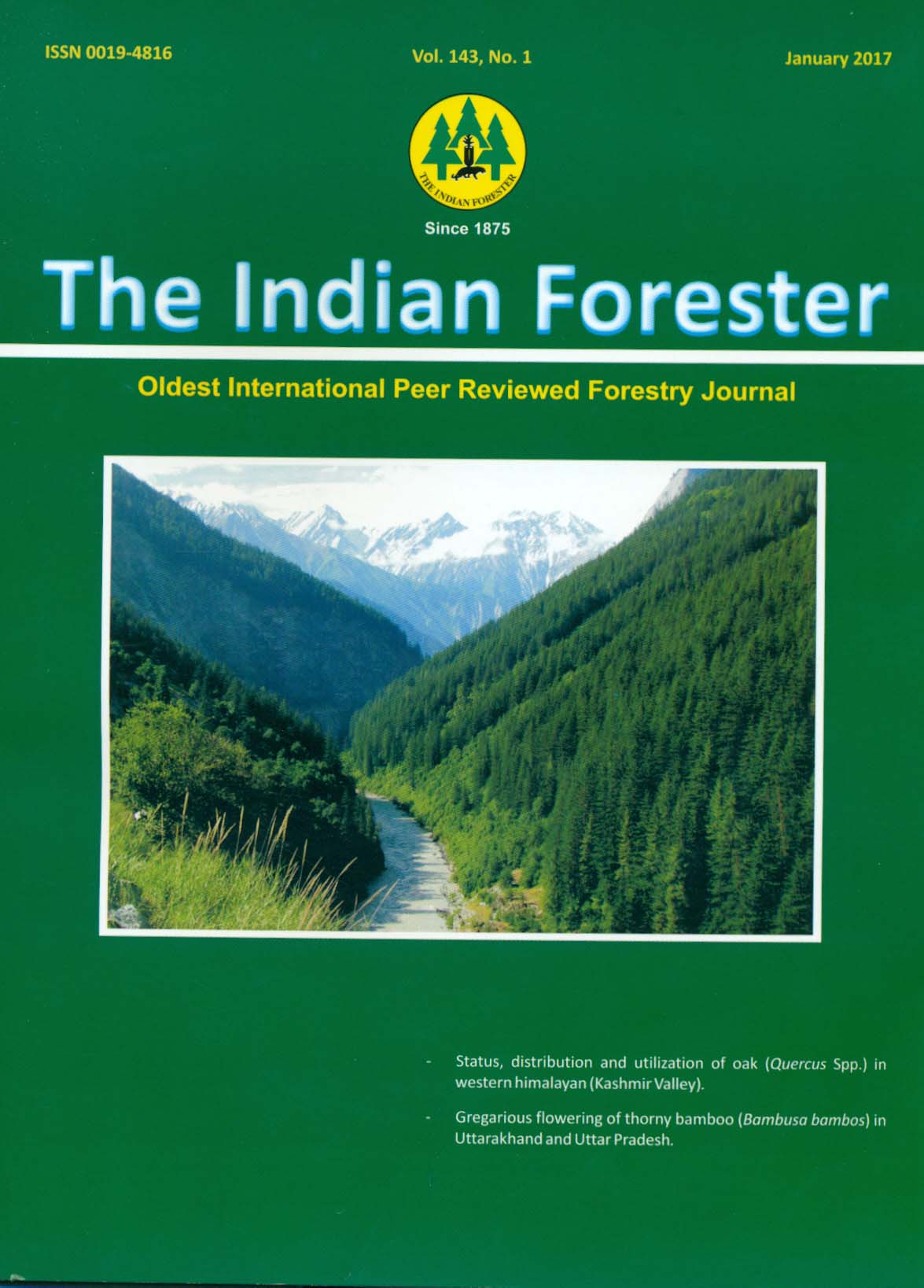Perception of Local People towards Blazing Mountain Due to Forest Fire in Changing Climatic Scenario of Uttarakhand Himalaya: A Need for Scientific Intervention for Sensitization and Conservation and Livelihood Sustainability of Region
DOI:
https://doi.org/10.36808/if/2017/v143i1/113504Keywords:
Forest Fire, Community Participation, Livelihood Sustainability, Scientific Intervention.Abstract
Forest Fires strongly affect the distribution and abundance of plant species, habitats of animals and hence landscape properties. Fire, whether natural or anthropogenic, is a widespread and recurring phenomenon in Indian forests. The causes of the forest fires can be classified into three main categories (i) Natural causes, (ii) Intentionally/Deliberately caused by man and (iii) Unintentionally/Accidentally caused by man. Around 90% of the forest fires in India are anthropogenic in nature. Fires strongly affect the distribution and abundance of plant species, habitats of animals and hence landscape properties.
The local people and community participation always been considered for management and utilization activity of fire and natural resources. Forest Fires in Uttarakhand have till now been fought with conventional methods. Conventional methods are insufficient and should be coupled with the technological advancements in order to get better fire management strategy. During last two decades scientific world has made considerable advancement in monitoring and warning regarding the outbreak of forest fires with the help of GIS and satellite technology. Beside it the use of these resources should be gear up for sustainable livelihood development. This paper highlight the people perception and how scientific intervention coupled with community approach can be helpful for fire reduction and better utilization of natural forest wealth.
References
Agee James K. (1990). The historical role of fire in Pacific Northwest forests. In Natural and prescribed fire in Pacific Northwest forests. Corvallis, OR: Oregon State Univ. Press. chapter 3.
Arnold J.E.M. (1997). Social dimensions of forestry's contribution to sustainable development. XI World Forestry Congress, 13-22 Oct., Antalya, Turkey.
Chandran, Manoj, Sinha A.R. and Rawat R.B.S.(2011). Replacing controlled burning practice by Alternate methods of reducing fuel load in the Himalyan Long leaf Pine (Pinus roxburghii Sarg.) forests. In Wild fire 2011,5Th International Wildland fire conference South Africa.
Dimopoulou M. and. Giannikos L. (2002). Towards an integrated framework for forest fire control. European journal of operational Research, 152: 476-486.
FSI (2003). Forest Survey of India. State of Forest Report, 2003.
Gubbi S. (2003). Fire, fire burning bright! Deccan Herald. Bangalore. India. Available from http://www.wildfirefirst.info/images/ wordfiles/fire.doc (accessed October, 2005).
http://www.samhita.org/social-organisation/avani-bio-energy/#sthash.ZfGJ37kO.dpuf
Jaiswal R.K., Mukherjee S., Raju K.D. and Saxena R. (2002).Forest fire risk zone mapping from satellite imagery and GIS. International Journal of Applied Earth Observation and Geoinformation 4(1): 1-10.
Prabhakar R., Somanathan E. and Mehta B.S. (2006). How degraded are Himalayan forests? Current science, 91(1):61-67.
Rao K.S., Semwal R.L., Maikhuri R.K., Nautiyal S., Sen K.K., Singh K., Chandrasekhar K. and Saxena K.G. (2003). Indigenous ecological knowledge, biodiversity and sustainable development in the central Himalayas. Tropical Ecology, 44(1):93-111.
Rawat B. and Rawat J.M. (2014). Perception of Students towards Conservation of Forest Resources: a case study from Western Himalaya, India. International J. Advanced Research, 2(8): 53-61.
Robichaud P.R. (1996). Spatially-varied erosion potential from harvested hillslopes after prescribed fire in the Interior Northwest. Ph.D. dissertation Moscow, ID: University of Idaho.
Roy P.S. (2000). Assessment of Forest fire in India through Remote sensing. Century Status Report in project Planning Workshop on the Scientific dimensions of forest fire, organized by International Council of Science and technology in developing Countries, Chennai during March 27-29.
Ryan Kevin C. and Noste Nonan V. (1983). Evaluating prescribed fires. Wilderness Fire Symposium; November 15-18; Missoula, Mont. 230-238.
Samant S.S., Dhar U. and Rawal R.S. (2001). Diversity and distribution of wild edible plants of Indian Himalaya. In: Plant Diversity of the Himalaya. Nainital: (Pande, P.C. and Samant, S.S., ed.) Gyanodya Prakashan; pp. 421-482.
Simard A.J. (1991) Fire severity, changing scales, and how things hang together. International J. Wildland Fire 1: 23–34. doi:10.1071/ WF9910023.
Singh S.P., Adhikari B.S. and Zobel D.B. (1994). Biomass, productivity, leafy longevity, and forest structure in the central Himalaya. Ecological Monograph, 64: 401-421.
Walstad J.D., Radosevich S.R. and Sandberg D.V. (1990). Natural and prescribed fire in Pacific Northwest forests. Oregon State University Press, Corvallis, OR
Wells Carol G., Campbell Ralph E., DeBano Leonard F., Lewis Clifford E., Fredriksen Richard L., Franklin E. Carlyle, Froelich Ronald C. and Dunn Paul H. (1979). Effects of fire on soil, a state-of-knowledge review. Gen. Tech. Rep. WO-7. Washington, DC: U.S. Department of Agriculture, Forest Service. 34 p.
Downloads
Downloads
Published
How to Cite
Issue
Section
License
Unless otherwise stated, copyright or similar rights in all materials presented on the site, including graphical images, are owned by Indian Forester.





